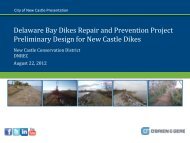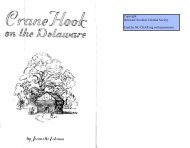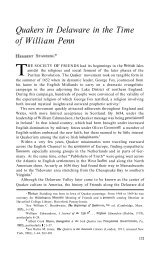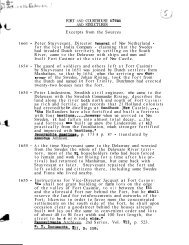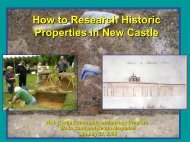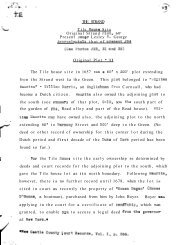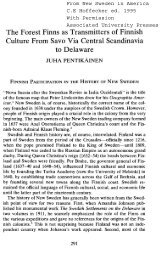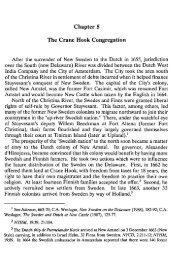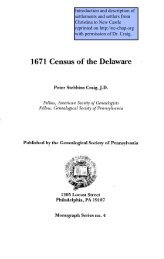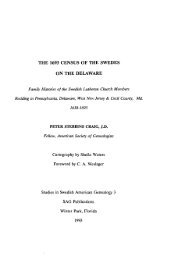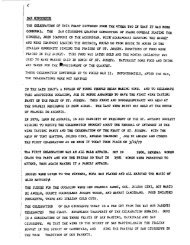1978 thesis - NC CHAP
1978 thesis - NC CHAP
1978 thesis - NC CHAP
Create successful ePaper yourself
Turn your PDF publications into a flip-book with our unique Google optimized e-Paper software.
NEW CASTLE UNDER THE DUKE OF YORK:<br />
A STABLE COMMUNITY<br />
Louise B. Heite<br />
A <strong>thesis</strong> submitted to the Faculty of the University<br />
of Delaware in partial fulfillment of the requirements<br />
for the degree of Master of Arts in American Studies.<br />
June <strong>1978</strong>
PREFACE<br />
The following pages contain a microscopic history of the town<br />
of New Castle, Delaware, concentrating on the Duke of York period.<br />
Derived from an intimate, rather journalistic reading of the records,<br />
and from a close look at landholding patterns, this paper describes a<br />
stable community.<br />
Ce rtain inconsistencies appear from time to time, particularly<br />
in the spelling of proper names. There were three or four languages<br />
current in New Castle during the period. In the seventeenth century,<br />
spelling was a creative art. The record-keepers wrote what they<br />
heard, not necessarily what was said. Thus Alricks may be Alrigs<br />
or Alrichs ; De Ring may be DeRingh or deRing or Dering. Tayne<br />
appears as Teine, Tyne, deTine, and Fynes in different records ;<br />
iii
iv<br />
Tayne was also known as Lapierre. The author has made no attempt<br />
to standardize names in either the title traces or in direct quotations;<br />
only in the narrative body are proper names subjected to modern<br />
orthography.<br />
The land title traces appear in the body of the paper, and not in<br />
an appendix. Because this body of maps and data is so important to an<br />
understanding of the town, it was deemed best to include it with the rest<br />
of the description.<br />
The author has refrained from trying to draw broad conclusions<br />
about seventeenth-century life from this study. An examination of one<br />
town during a very restricted period cannot yield much on its own about<br />
other towns in other times. The comparisons may be made, and they<br />
will be valid, when equally close explorations of other places are<br />
available .<br />
The frequency of quotations in this paper is a reflection of the<br />
author's belief that the records, where they can, should speak for<br />
themselves. Through a simple rearrangement process, putting records<br />
of like events together, the story has emerged on its own.
2<br />
its participants were holding office in New Castle. The strife known<br />
as thel!Dyke Riot" that shook New Castle for a few days in 1675 was<br />
unrelated to disturbances elsewhere. At no time did there develop<br />
the enmity between the Dutch settlers and the English that eventually<br />
grew up in New York.<br />
The following pages will examine several aspects of<br />
community life in the Delaware colony~s'principal town of New Castle.<br />
As the seat of government, New Castle seems to be the most likely<br />
place for events of significance to have occurred.<br />
This paper will show that the early (Delaware colony enjoyed<br />
stability, independence, and a strong sense of self- identity. These<br />
characteristics will be demonstrated through a close study ofland-use<br />
patterns in the town; relationships between the Governor and the Court;<br />
the careers of several prominent citizens ; relationships with the<br />
Native American population; the record of crime; church - state<br />
relationships, and what might be termed neighborl lines^'^.<br />
Although the paper will concentrate on the town of New Castle,<br />
the countryside around the town and the other courts on the river offer<br />
valuable supplementary mate rial.<br />
The information is nearly all found in public documents. Very<br />
few of Delaware's earliest citizens kept private diaries or memoirs;<br />
none are known to exist. A few travellers described New Castle
to a greater or lesser degree, but not in much detail.<br />
3<br />
Fortunately for the historian, Delaware's early public servants<br />
were a wordy bunch. What should be dry and formulistic records are<br />
crowded with glimpses of social life. The lack of private records has<br />
hardly hindered our understanding of the lives of private citizens.<br />
A judicious reading of public records, looking for peripheral details,<br />
should be standard practice in any history. In the absence of private<br />
records, this is the only feasible approach.<br />
This paper cannot be considered a definitive study of Delaware<br />
in the seventeenth century. Limitations of time preclude more than a<br />
cursory look into certain fascinating questions. Among them are<br />
the relationship between Delaware1 s three counties and he r neighbor<br />
colonies; road building and the growth of land transportation<br />
throughout the seventeenth century; the place of women and blacks in<br />
the early colony; the amalgamation of several ethnic groups into a<br />
cohesive population; the impact of the founding of Pennsylvania on<br />
Delaware's political and economic fortunes , and a comparison of<br />
individual careers in New York, Philadelphia and the Delaware.
settlement, at New Amstel. 2<br />
13<br />
In September of 1664, after they had occupied New Amsterdam,<br />
Nicholls, Cartwright, and Maverick commissioned Carr to go to the<br />
Delaware and subdue the Dutch. Carrls instructions required him to<br />
act with great restraint, to use force only as a last resort. He was to<br />
offer the people of New Amstel all the liberties enjoyed by the English<br />
on English lands, freedom of conscience in religion, and a continuance<br />
for at least six months of their civil government, provided that they<br />
3<br />
take an oath of allegiance to England.<br />
Only Alexander DIHinojossa, the commander of the Dutch<br />
forces in Fort Casimir, and a handful of soldiers, resisted. Carr<br />
reduced them handily. 4<br />
The Articles of Agreement under which Carr took command of<br />
New Amstel indicate that he followed his instructions: the transition<br />
from Dutch to English rule passed quietly, if not entirely peacefully.<br />
5<br />
The articles contain eight points:<br />
1. That all the Burgers and Planters will submit themselves<br />
to his Majesties authority without making any Resistance<br />
2. That Whoever of what Nation soever doth submit to his<br />
Majesties Authority shall be protected in their Estates real1<br />
and pe rs onall whatsoever, by his Majesties Lawes and Justice<br />
3. That the present Magistrates shall be continued in their<br />
Offices, and jurisdiccions to exercise their Civil1 Power as<br />
fo rme rly.<br />
4; That if any Dutchman or other person shall desire to depart<br />
from this River, that it shall be lawful1 for him so to doe,<br />
with his Goods within six Months after the date of these articles.
5.That the magistrates and all the Inhabitants (who are<br />
included in these articles ) shall take the Oaths of Allegiance<br />
to his Majestie and of Fidelity to the present Government.<br />
6. That all the People shall Enjoy the Liberty of theire<br />
Conscience, in Church Discipline as formerly<br />
7. That whoever shall take the Oathes is from that time a<br />
free Denizen, and shall enjoy all the privileges of Trading into<br />
any of his Majesty's Dominions as freely as any Englishman, and<br />
may require a Certificate for so doing.<br />
8. That the Scout, the Burgomasters Sheriffe and other Inferior<br />
Magistrates shall use and Exercize their Customary Power in<br />
administration of Justice, within .their precincts, for six<br />
monthes or until1 his Majesties pleasure is further knowne.<br />
The officials who signed the Articles of Agreement for the Dutch<br />
were Fop Outhout, Henry Johnson, Gerritt Sanders Vantiell,<br />
Hans Block, Lucas Peterson, and Henry Costurier. Much later, in<br />
1682, a list of 117 Dutch and Swedes appears in the court records as<br />
desiring to be naturalized. Many of these men had been on the<br />
Delaware since the Dutch occupation. 7<br />
Each of the Duke of York's administrators dealt with the<br />
Delaware colony slightly differently. The relationship between the<br />
court of New Castle and the governor in New York is the clearest<br />
during the time between 1668 and 16 82 ; Francis Lovelace, who was<br />
governor from 1667 to 1673, was a conscientious administrator who<br />
left copious records. Much of his correspondence with the Delaware<br />
magistrates survives. From the 1674 restoration of English rule to<br />
Penn's 1682 grant, Edmund Andros was governor; both his records<br />
and the local court records exist for this period. Close comparisons
authorized the justices to transfer their loyalty and the land described<br />
in Pennls deed, to William Penn. The new proprietor, on his part,<br />
promised immediately to honor all good titles to land on the Delaware.<br />
Also, he recommended that the court continue to follow and enforce<br />
the laws of New York until such time as he could call an assembly<br />
and establish his own laws. lo7 Penn and Markham attended the<br />
108<br />
monthly court sessions at New Castle through February of 1683.<br />
The changes in government under Penn are beyond the scope<br />
of this present paper. However, on a community level, a look through<br />
the court records of the next decade indicates little functional change.<br />
The same people serve on the court; Ephraim Herman continues as<br />
clerk, and the same names appear as landowners and in lawsuits.<br />
Although the period of transition involved uncertainty and doubt, it<br />
appears that New Castle's stability continued intact into Pennls rule.
New Castle, the re was surprisingly little speculation. For four years,<br />
from 1683 to 1686, Penn's government conducted a census and assessment,<br />
which has been published. 20 Lot owners in New Castle are readily<br />
distinguished, for their town lots are listed separately from country<br />
properties. Most of the landowners had one or two lots; only a few had<br />
more than six. Only two of these seem to have been engaged in<br />
speculation on any scale. Moreover, few owners dramatically increased<br />
or decreased their holdings throughout these four years.<br />
CENSUS OF LOT OWNERS<br />
NAME 168314 168415 168516 168617<br />
Peter Alricks 2 2 2 2<br />
Justus Anderson (Andries) 1 1 1 1<br />
Ambrose Baker 5 5 - 3<br />
Giles ~Barrett 2 - - -<br />
John Bisk 6 3 2 2<br />
Edward Blake - - - 1<br />
John Boyer 2 1 2 1<br />
Joseph Bu rnham - 1 - -<br />
Anthony Bryant 8 3 1 1<br />
John Cann 4 2 2 2<br />
Edmund Cantwell 1 1 1 -<br />
Judith C rawfo rd 2 - - -<br />
William Cros se (Larrain) - 1 1 -<br />
Claes Daniel* 5 - 1 - 1<br />
John Darby - - - 1<br />
Moses DeGan 1 - 1 1<br />
Johanne s deHae s 2 1 1 2<br />
Arnoldus Delagrange 4 3 3 3<br />
Aemilius deRing 5 5 3 3<br />
Mathias de Ring 1 3 2 2<br />
Mathyas de Voos ;k - 1 - -<br />
Elde rt Egbe rts 1 - - -<br />
*Indicates absence from other land records. These landowners may<br />
have never properly recorded their purchases, or the record may be<br />
lost.
NAME<br />
67<br />
168314 168415 168516 168617<br />
John ffolkJ6<br />
Sybrant ffolk*<br />
John fforat<br />
John Garretson:::<br />
Josyn Hamilton *<br />
Richard Halliwell<br />
Adam Hay<br />
Hubert Hendricks<br />
1<br />
1<br />
-<br />
7<br />
-<br />
-<br />
1<br />
2<br />
-<br />
-<br />
1<br />
-<br />
-<br />
-<br />
-<br />
-<br />
1<br />
1<br />
-<br />
-<br />
-<br />
1<br />
-<br />
1<br />
1<br />
-<br />
-<br />
John Hendrickson<br />
Widow Hiberts:::<br />
Garrett Johnson<br />
Samuel Land<br />
Dorcas Land<br />
- - Lor rain (Wm. Cros ie? )<br />
1<br />
-<br />
-<br />
1<br />
-<br />
1<br />
1<br />
3<br />
-<br />
1<br />
-<br />
-<br />
1<br />
-<br />
3<br />
3<br />
-<br />
-<br />
1<br />
-<br />
3<br />
-<br />
3<br />
-<br />
Engelbe rt Lott<br />
Abraham Man<br />
John Mandy<br />
Mary Mandy<br />
2<br />
-<br />
1<br />
-<br />
3<br />
2<br />
1<br />
-<br />
3<br />
-<br />
3<br />
-<br />
3<br />
-<br />
1<br />
John Moll<br />
George More<br />
John Williams Neering<br />
6;<br />
1<br />
2<br />
5<br />
-<br />
-<br />
4<br />
1<br />
-<br />
4<br />
-<br />
-<br />
Richard Noble:::<br />
Gov. Penn*<br />
-<br />
1<br />
-<br />
-<br />
-<br />
-<br />
2<br />
-<br />
Josyn Semple<br />
Gerrit Smith<br />
2<br />
3<br />
1<br />
3<br />
1<br />
-<br />
-<br />
-<br />
John Smith<br />
Thomas Spry*<br />
2<br />
6<br />
2<br />
4<br />
2<br />
-<br />
2<br />
3<br />
Dominy Peter Teschenmaker6<br />
Isaac Tayne 1<br />
Sybrant Volk -<br />
6<br />
-<br />
1<br />
2<br />
4<br />
-<br />
2<br />
4<br />
-<br />
He nd rick Vandenbu rg 4 5 5 3<br />
R.eyne r Vaqde rculin<br />
Mathyas Vanderheyden<br />
12<br />
-<br />
4<br />
-<br />
4<br />
-<br />
4<br />
1<br />
James Walliam<br />
John Walker<br />
2<br />
-<br />
1<br />
-<br />
2<br />
1<br />
2<br />
-<br />
William Welch<br />
Susannah Welch<br />
Sarah Welch<br />
1<br />
-<br />
-<br />
2<br />
-<br />
-<br />
2<br />
-<br />
1<br />
John White*<br />
Gerardus Wessels<br />
1<br />
-<br />
- 1<br />
z<br />
-<br />
1<br />
1<br />
1<br />
-<br />
He ndrick Williams<br />
John Williams (Nee ring? )<br />
3<br />
-<br />
2<br />
2<br />
2<br />
-<br />
2<br />
2
Maps and Title Traces<br />
The following maps and title traces graphically describe the<br />
development of the town of New Castle from about 1670 to about 1690.<br />
The key map on page 75 shows the relationships between the block<br />
maps. In the key, each block bears a letter that corresponds to a<br />
detailed enlargement. Because the streets in the old part of New<br />
Castle have changed little since the seventeenth century, no modern<br />
map has been included.<br />
Enlarged maps, lettered A through K, show the property lines<br />
as they occurred in the 1670's and 1680's. Each parcel is numbered;<br />
the numbers correspond to the title trace and description of the parcel<br />
that follows. Certain of the lots show a building or buildings; these<br />
symbols indicate that specific mention of some sort of building occurred<br />
on one of the transactions involving that property. On Front Street, the<br />
crosshatch symbols represent buildings shown on the bank lot surveys.<br />
Features other than property lines also are shown on the<br />
enlarged maps. Map A shows the probable alignment of a street<br />
abandoned before 1683. Map F shows some of the larger properties<br />
on the edge of town, whose borders appear to follow the edge of usable<br />
high ground. And Map G shows several alternate locations for Thwart<br />
Street; because the street passed through low ground, it probably was<br />
impassable during the wet part of the year. The present alignment of





